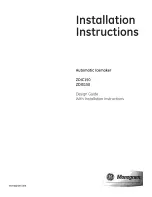
19
•
The high-efficiency compressor may make a pulsating or high-pitched sound.
•
Water running from the water bin to the evaporator plate may make a
splashing sound.
•
Water running from the evaporator to the water bin may make a splashing
sound.
•
As each cycle ends, you may hear a gurgling sound due to the refrigerant
flowing through your icemaker.
•
You may hear air being forced over the condenser by the condenser fan.
During the harvest cycle, you may hear the sound of ice cubes falling into the
ice storage bin.
•
When you first start the ice maker, you may hear water running continuously.
The ice maker is programmed to run a rinse cycle before it begins to make ice.
Preparing the Ice Maker for Long Storage
If the ice maker will not be used for an extended period of time, or is to be moved
to another location, it will be necessary to drain the water from system.
1.
Shut off the water supply at the main water source.
2.
Disconnect the water supply line from the water inlet valve.
3.
Disconnect the drain pipe to the drain line or floor drain.
4.
Allow the ice maker to run for an hour or more until all remaining ice cubes
have been ejected from the ice maker assembly.
5.
Shut off the electric supply at main electrical power source.
6.
Screw off the nut of the water drain hole at the back of the machine, drain out
water residue completely
(do not loosen or screw off the nut at other times)
,
then tighten the
nut after finishing.
7.
Drop the door open to allow for circulation and prevent mold and mildew.
8.
Leave water supply line and power cord disconnected until ready to reuse.
CLEANING AND MAINTENANCE
If the ice maker is left unused for an extended period, before the next
use it must be thoroughly cleaned. Follow carefully any instructions
provided for cleaning or use of sanitizing solution. Do not leave any
solution inside the ice maker after cleaning.













































